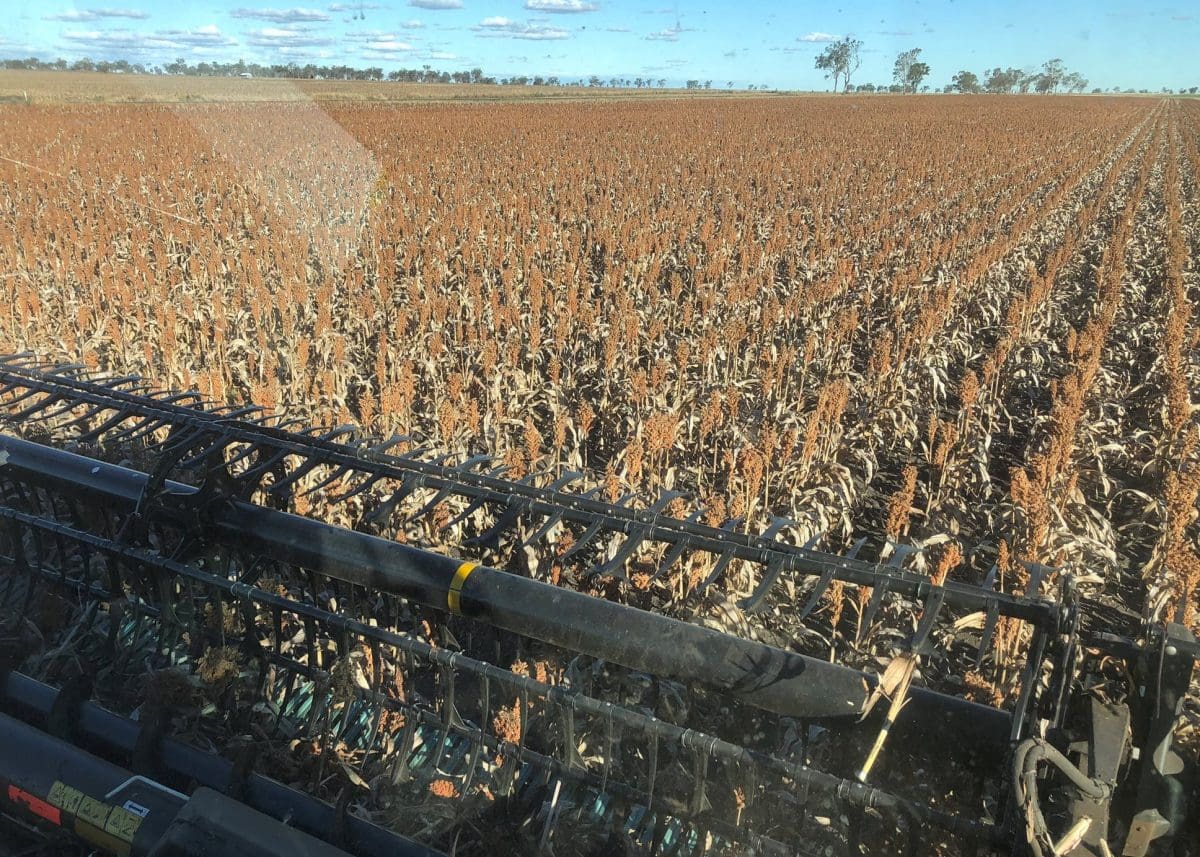
This year’s sorghum harvest has finished in July for many growers, months later than normal. Photo: Lance Wise, Bowenville
HARVEST of Australia’s smallest sorghum crop in 50 years is drawing to a close in central and southern Queensland to mark the end of a late and challenging season from start to finish for many growers.
In its latest Grain and Feed Update for Australia, the USDA Foreign Agricultural Service (FAS) pegged the crop at 300,000 tonnes, 2000t above the ABARES forecast, and exports at 40,000t, down from 91,000t in the previous year.
Australian sorghum is grown almost entirely in Queensland and northern New South Wales, with planting in earnest usually starting in September in NSW and southern Queensland.
Last year’s fierce drought gripped both regions during the primary planting window, and rain fell in late December and January.
It gave some growers enough rain to plant intended area at a much later time than normal, and has pushed harvest into the May-July window instead of the normal March-April.
Central Queensland is the other major producing area, and planted at the normal time after Christmas, but dryland crops had little follow-up rain, and high screenings and low yields have been a feature for many growers.
“CQ still has some issues with screening and moisture,” Delta Agribusiness broker Tom Vanzella said.
“It hasn’t been a good year up there for sorghum.”
The late arrival of sorghum planting rains in NSW prompted many growers to hold over fallow for planting of a winter crop, and the small area of NSW sorghum planted is estimated by ABARES to yield 3t per hectare.
This compares with 2t/ha for Queensland, and highlights the lack of in-crop rain in many districts.
Tiny export program
While Australia normally loads several bulk cargoes of sorghum for export from May onward, with China the major market, only a small containerised export program has been possible this year.
Australia exported 1425t of sorghum in March-May 2020, compared with 18,377t in the corresponding 2019 period.
The lateness of the crop, combined with winter rain in some areas , has made harvest slow, and grain-moisture levels high, which has made the need for drying prior to packing for export necessary in some cases.
Further troubling the sorghum complex has been the closure last month of United Petroleum’s Dalby Bio-Refinery, which for years has been the buyer of off-spec sorghum for use in ethanol production.
Poultry farms and piggeries are the major non-industrial domestic users of sorghum when it is priced attractively, but a hike in January on trade shorts to more than $500/t delivered Brisbane, close to double its current value, priced it out of many rations.
Sorghum does have some loyal users, mostly located in production areas, and these been soaking up much of the grain as soon as it became available.
Improved new-crop outlook
Prospects for the crop which will be planted in coming months are much improved, with FAS forecasting production at 1.4Mt, and exports at 500,000t.
In its latest crop report issued last month, ABARES pegged the Queensland sorghum crop at 260,000t from 130,000 hectares, and the NSW crop at 36,000t from 12,000ha, with an extra 2000t coming from the burgeoning Ord region in Western Australia.
The five-year average sorghum production to 2018-19 is 416,000t in NSW, and 1 million tonnes (Mt) in Queensland, and the crop now being harvested compares with 1.16Mt harvested last year.
In recent years, Australia has exported as much as 1.6Mt from the crop harvested in 2016, with the low prior to this year being 277,000t shipped in 2018.
“Although seasonal conditions have improved dramatically the next planting will commence as early as September 2020 and as late as January 2021,” the FAS report said.
“Forecasts are for above-average rain in northern NSW and southern Queensland in the lead up to the planting window, leading to expectations of a vastly increased area of planting.
FAS said CQ received good wet-season rains from December to March, and good follow-up dry-season rainfall, which has improved subsoil moisture in the lead-up to the next planting period.
“Both regions are well placed at this early stage to rebound for the 2020-21 crop.”
Independent forecaster Lachstock Consulting expects the crop soon to be planted will produce 1.6Mt with upside.
“We flag a 10-per-cent increase if a widespread planting rain occurs in southern Queensland during September-October,” Lachstock’s monthly sorghum S&D report released this week said.
“North-east NSW and the Liverpool Plains areas are in great condition, and set up for a solid plant.”



HAVE YOUR SAY